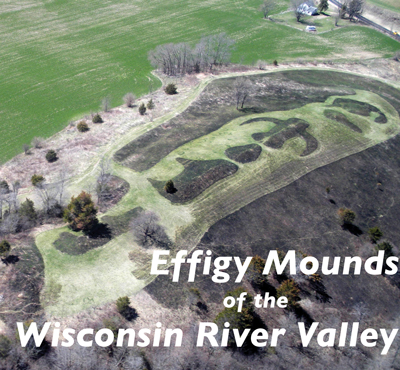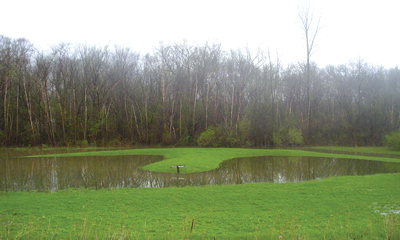|
|
 Frank's Hill is across the river from Muscoda, Wis. (Mark Culp)
Effigy Mounds of the Wisconsin River Valley Huge bears, long-tailed water spirits and birds with wingspans reaching up to a quarter-mile settled into the Wisconsin River valley centuries ago. Thanks to the work of preservationists, people can easily visit many of these effigy mound sites today. Built one basketfull of earth at a time, these earthworks have spoken to many generations of people since their construction about 1,000 years ago. No one knows exactly what they meant to their builders, though we have a pretty good idea through the beliefs of modern Ho-Chunk people, who trace their lineage back to the mound builders. Wisconsinites are proud to point out that these earthen creatures are found almost exclusively in southern Wisconsin and into the Driftless Area, including the corners of Illinois, Iowa and Minnesota, while round (conical) and long (linear) mounds are found here and across much of the United States. “It is an identity marker for this part of the world,” said Ernie Boszhardt, an archaeologist with the Center for Wisconsin Archaeology at UW-Baraboo/Sauk County. Conical- and linear-mound building also stretched over thousands of years, while effigy-mound building probably spanned only a few hundred years. The archaeological record shows that effigy mound builders were relatively insular, early isolationists in trade, one might say. While archaeological remains of many earlier Americans show far-flung trade networks bringing goods to and from the shores of Lake Superior, the Rockies and the Gulf of Mexico, material traces of the effigy mound builders show that they preferred to “buy local.” They had everything they needed, pointed out Amy Rosebrough, assistant state archaeologist with the Wisconsin Historical Society. “The Driftless Area was a very productive environment,” she said.  This bird mound, which can be seen on the south side of Highway 60 west of Muscoda, is outlined by high water from the Wisconsin River. (Mark Culp) Effigy mound builders lived near rivers in groups of about 50 during the summer: fishing, growing some crops and gathering mussels and berries. In the fall, they moved to the uplands to harvest nuts and hunt deer. In the winter, they divided into smaller family units and stayed warm in rock shelters, hunting deer, making tools, telling stories and consuming the stores of summer’s surplus. Effigy mounds were built when people gathered again in larger groups in the spring or summer, explained Boszhardt. Most, though not all, contain burials, usually one or two in the heart or head of the effigy. They may have served as a way of honoring those who didn’t make it through the winter. Mound builders probably bonded as a group as they scraped earth into baskets, heaping it into the silhouettes of animals — bears of the earth and the birds of the sky, as well as long-tailed, underwater creatures associated with the underworld. The effigies likely represented clan groups and may have marked territory. Most are now about three feet high. Along the Mississippi, bears and birds predominate, while more long-tailed creatures rise from the land as you move east. A map of publicly-accessible effigy mounds along the Lower Wisconsin is available from Cultural Landscape Legacies, Inc., (CLLI) whose leader, Mark Cupp, has developed a widely-used protocol for maintaining mounds in a respectful, non-damaging way. The map is available by contacting the Lower Wisconsin State Riverway Board, 202 North Wisconsin Avenue, P.O. Box 187, Muscoda, WI 53573, by emailing [email protected] or calling (608) 739-3188. Cupp is the executive director of the smallest state agency in Wisconsin, the Lower Wisconsin State Riverway Board, the agency charged with maintaining the viewshed of the Lower Wisconsin as seen from the river. Unlike the Mississippi, the majority of recreational boats on the Lower Wisconsin are kayaks and canoes, so the agency keeps their interests at heart. The missions of the Wisconsin Riverway and mound preservationists intersect in the knowledge that, once lost, these resources are impossible to recreate.
Bloyer / Twin Lizard On a warm summer day, I met Don Greenwood of CLLI to visit effigy mounds near Muscoda and Avoca. First, we visited the Bloyer Mound Group, sometimes called the Twin Lizard Group, on Department of Natural Resources property along the Wisconsin River. It includes about 31 mounds, including two that could be frogs, lizards or tailless turtles. The largest is about 160 feet long. In the jungle of midsummer undergrowth, the mounds are virtually impossible to see. In the winter, especially with a dusting of snow, effigy mounds are more visible. It’s worth noting, said Boszhardt, that the mound builders occupied a landscape much different than the one we see today. Much of what is now woodland was then prairie, and the lowland undergrowth that we squinted through was rare. Effigy mound builders may have been swatting mosquitos, but they weren’t picking their way through the tangle of undergrowth that makes much of the Driftless seem almost impassible in midsummer. Frank's Hill Highway 60 follows the final 82 miles of the Wisconsin River to the Mississippi near Prairie du Chien. From the Bloyer group, we took Highway 60 to Highway 193 north, where we pulled off quickly at Frank’s Hill, a group of effigy mounds on high ground with stunning views of the surrounding hills and fields. It’s easy to see why people marked this as a sacred space. The hill is mowed, except for the mounds, so they are easily seen. The mounds are as large as 100 feet across and about three feet high. In July, the effigy mounds are covered with Queen Anne’s lace, grasses and wildflowers. The Three Eagles Foundation maintains Frank’s Hill, and the group keeps alive the legacy of Frank Shadewald, who preserved the mounds. Shadewald saw connections between effigy mound builders and Mayan culture, especially in calendar mounds across the road that may have been used as an agricultural timetable. Shadewald’s Mayan connections are not mainstream archaeological interpretations, but they do show how people continue to find meaning in these 1,000-year-old monuments, and his preservation work was invaluable. He died in 2013. Friends and neighbors have continued his legacy. Frank’s Hill is open to the public and hosts events on the equinoxes and solstices. “We welcome religious ceremonies up there,” said David Martin, now president of the Three Eagles Foundation. “We don’t discriminate against what religious groups might come up and use the hill.” Besides mowing, the foundation occasionally burns the mounds and is seeding them with prairie plants. “Once you’re up there, I think you’ll remember being up there,” Martin said. “You can look in 360 degrees. My, what a view.” I agreed.
Avoka, Wyalusing, Pikes Peak From Frank’s Hill, Greenwood and I drove to Avoca, where an ancient gathering place is now a modern one: a city park on the east edge of town. Numerous circular humps in the park are easy to spot, and in some places they touch playground areas. A backwater lake is a popular fishing spot, and the park includes a shady campground. Other conical, bear and bird mounds along the Lower Wisconsin shores are also public. A bird effigy can be seen from Highway 60 west of Highway 80, and a wayside on the north side of Highway 60 between Prairie du Chien and Wauzeka contains more mounds. At the mouth of the Wisconsin, the magnificent Wyalusing State Park includes dozens of well-preserved mounds along the blufftops, overlooking the confluence of the Wisconsin and Mississippi and close to campsites. Across the river, effigy mounds are found at Pikes Peak State Park and, of course, Effigy Mounds National Monument, including its Sny Magill unit. Between Baraboo and the river, Devil’s Lake State Park contains effigy mounds, and more are found in the Muscoda area at the Ho-Chunk bison ranch. Many more are already gone.
Man Mound and GhostEagle “There used to be thousands of these cultural remnants on the landscape,” Greenwood said. “Many have been lost, to the plow, to roadways, to development.” The only known extant effigy mound in the shape of a man, at Man Mound Park, Baraboo, was cut through the legs by a highway project. A magnificent bird effigy, called the Ghost Eagle because it was unnoticed until its faint image was spotted in aerial photos, has a wingspan of a quarter mile, but annually diminishes from being plowed. Protecting the Mounds Effigy mounds, as likely burials, are protected from excavation under Wisconsin law, and property owners can get property tax exemptions if their property contains Indian mounds. A bill in the Wisconsin legislature last winter drew thousands of Ho-Chunk and other protesters because it required excavation for proof of burial protection. Another proposal would change the current fines and prison time that are penalties for intentionally destroying burial mounds. Committee meetings on the bill resumed in early August. Kurt Sampson, principal archaeologist at Gathering Waters Archaeology, LLC, and president of the Wisconsin Archaeological Society, maintains the Effigy Mounds Initiative Facebook page, which he started to share his “lifelong love affair with mounds.” He said the site “very quickly and shockingly” became a focal point of mobilization against the proposed burial protection changes, which Sampson says “aimed at dismantling every protection aspect of the existing law.” When visiting effigy mounds, it’s important to respect that these sites still hold a sacred value to people. Avoid walking on the mounds or picking flowers, and don’t disturb objects left intentionally, such as pouches of tobacco or ribbons tied to tree branches. “Just be aware that you’re entering a burial place, a cemetery, and act accordingly,” Rosebrough advised. To get involved in preserving effigy mounds contact one of the organizations mentioned above. For preservationists, Native Americans and archaeologists, the effigy mounds mark intersections of spiritual meaning and material culture, universal human impulses and their uniquely local expression. “It’s a wonderful piece of living history,” Martin said. Sara Millhouse lives in Shullsburg, Wis. Her last story for Big River was “Closing the Button Factory,” July-August 2016. |
|